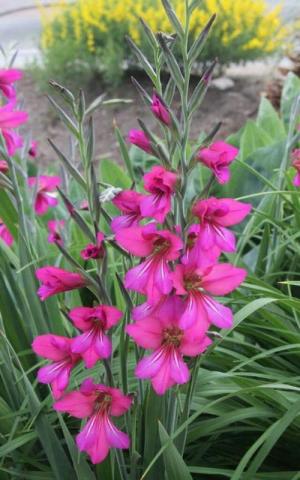Plant Byzantine gladiolus in full sun and well-drained soil
Long ago and far away, a Greek citizen named Byzas asked an oracle where to start his new colony. The cryptic answer was “opposite the blind.” It made little sense until Byzas traveled to a city on the Bosporus Strait and realized the Greeks were blind for not using this superior harbor. Here he established Byzantium, later called Constantinople. More than a million people lived in the city of Constantinople. This is estimated to have been one in eight of all the people living on earth at the time.
Byzantium also gave the world a graceful wildflower with small, delicate blossoms of vibrant magenta. These Byzantine gladiolas look like graceful orchids. Introduced in 1576, Byzantine gladiolus (Gladiolus communis ssp) were a common sight in fields of grains. They are sometimes called corn lily, because the bulbs survived deeper in the soil than ancient plows could dig, and they popped up in among the wheat or “corn,” which is what Europeans call any grain.
Byzantine gladiolus survive in USDA Zone 6, or Zone 5 with protection. Your gladiolus will reproduce and eventually form huge clumps of blooming plants.
For best results, plant this tough perennial in full sun and well-drained soil. The bulbs, actually called corms, are smaller than those of modern gladiolus, and unlike modern glads, these are planted in the fall and survive the winter.
Next spring you will be greeted with slim, strap-like leaves and thin, wiry, stems topped with 10-12 dark-purple buds that open in late spring or early summer when iris and peonies bloom. Soon after blooming, the leaves die back while the bulbs go dormant during the warm summer.
These hardy bulbs are easy to grow and flower just about anywhere. They do prefer full sun to light shade with soil that drains well.
Plant the corms (bulbs) three to four inches deep, about six inches apart. You may want to mulch them with straw, oak leaves, or pine needles to protect them from winter cold.
The secret to having any bulb come back year after year is to let the plant’s leaves wither and die naturally so the corms can build up strength for next year's blooms.
You can increase the number of Byzantine Gladiolus by digging up the corms after a few years and separating the tiny baby-corms that grow from the original mother corm. These tiny corms can be transplanted, and after two or three years they will be fully grown and blooming.
These wiry flowers are not just carefree in the garden, but are exceptional cut flowers. You can give these tough perennials an annual feeding of slow-release bulb fertilizer, but even that isn't necessary.
Plant perennial Byzantine Gladiolus and you will have the perfect flower to bridge the gap between spring daffodil blooms and summer roses, because, like Rome and Byzantium, it is of two worlds.




















































